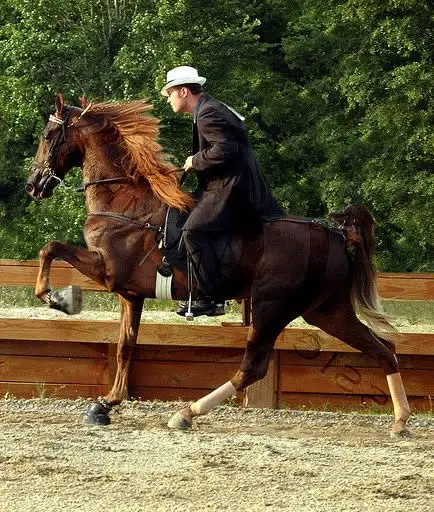History
Legendary for its beauty, stamina, and calm disposition, the popularity of this noble animal grew strong on the great southern plantations before the Civil War. It was learned that the horse could be ridden comfortably for hours because of his smooth, natural gait.
The phenomenal growth of this breed can be directly attributed to its intelligence and versatility. Beginning riders cherish the smooth, easy gait and the calm temperament of the Racking Horse. Veteran horsemen admire his beauty and ability to perform anywhere from the work field to the show ring.
There was a horse being shown in great numbers, a horse of a distinct type and characteristics, for which there was no specific judge, no showring category, no organization and ultimately no incentive for expansion and growth. The Racking Horse became a dream and a new and most significant chapter in equine history of this country was begun.
Knowing that this single foot horse called the racking horse had its origins rooted deeply in Walking Horse bloodlines, it was then realized the possibility of promoting this animal with no action device, no set tail and without the canter while spot lighting the docile nature and easily ridden lateral gait exemplified by the rack.
A group of Alabama businessmen headed by Joe D. Bright formed a corporation and initiated the legal maneuverings with the USDA to designate this horse as a distinct breed. A carefully studied program for this venture in the late 1960's was begun. He gathered knowledgeable horsemen long oriented in the breeding and raising of horses both for pleasure riding and show purposes to assist him in this effort. On May 23, 1971, a milestone in the equine history of America was reached. On this date the USDA recognized the Racking Horse Breeders' Association of America, thereby allowing a registry to be established to perpetuate the Racking Horse breed. Until this time the Racking Horse had been the only horse in the show rings of the nation not protected by a registry or a uniform set of rules. The primary function of the Racking Horse Breeders' Association was to "establish a registry to protect and perpetuate the breed".
The Racking Horse opportunity was presented to horses everywhere, and for many years the growth of the Racking Horse Breeders' Association was astounding. The selection of the name "Racking" was not to tie this horse to any specific state or region. The term "rack" was then the country nomenclature for the single foot.
The main objective and the philosophy of the Racking Horse Breeders was to create an organization that was within the economic reach of the marketplace that would serve the amateur horseman, the person doing his own training at home, to being a member, a breeder, and a showring participant.
An organization was needed for the people, to promote the people, the horses and give the people an opportunity for participating where they could feel secure and protected. The general membership should always have a voice in the association, so as not to drive them to another breed or out of the horse business altogether.
Eligibility for registration was determined upon the performance of the gaits natural to the breed, and in the beginning horses of all ages could be registered by gait performances.
The Racking Horse Breeders' Association actually laid the foundation and the incentive for the great trend towards the pleasure horse movement in the show ring today. When we began the Racking Horse Breeders' Association this type horse was oftentimes the largest group at the smaller shows. Even without a group or organization for promotion the interest and participation was great. This was a horse for the middle income people to enjoy at home, on trails, and at shows. The majority of the horses were shown on flat shoes or with very little pad. Once we promoted the idea of a separate and named breed and established the registry it grew faster than anyone ever dreamed.
The Racking Horse originated and was developed from within the ranks of the pleasure Walking Horse. At this time, in 1971, there was no promotion for the Walking pleasure horses and no efforts were being made to satisfy the demands of the pleasure world. Subsequently, the Racking Horse Breeders' Association grew at an astounding rate.
Behavior
Beginning riders have found the Racking Horse to be the answer to their prayers, not only for his extremely comfortable ride, but also because of his unusual friendliness to humans. Beginners and veterans alike can appreciate the opportunities generated by this intelligent, family oriented steed.
Function
The Racking Horse may be shown in saddle seat or western tack and attire, as well as in driving. Horses are shown in a long, natural mane and tail, but for saddle seat classes, the horse will have ribbons braided in the mane and forelock. It is also sometimes shown in hand, or in trail obstacle classes.
The Racking Horse Breeders' Association of America was originally formed as a vehicle for the promotion of horses shown without the artificial and extreme devices often seen in Tennessee Walking Horse and other gaited breed showing. However, the Racking Horse is one of the breeds often harmed by the inhumane practice of soring, prohibited at the federal level by the Horse Protection Act of 1970. Soring is an abusive practice used to accentuate the gaits of breeds such as the Tennessee Walking Horse and Racking Horse, in order to gain an unfair advantage in competition.[16] The RHBAA operates in conjunction with a Horse Industry Organization (HIO) to inspect horses before shows and sales.
The Racking Horse is also used as a trail and pleasure horse,[19] and the RHBAA has a versatility program in place through which Racking Horses can earn awards by participating in a variety of activities, including endurance riding.






